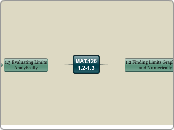MAT.126
1.2-1.3
1.2 Finding Limits Graphically and Numerically
Estimate a limit using a numerical or graphical approach
Numerical approach
Graphical approach
Notation
Existence of f(x)undefined
Learn different ways that a limit can fail to exist
Behavior that differs from the right and from the left
Unbounded behavior
Oscillating behavior
Dirichlet function
Study and use a formal definition of limit
1.3 Evaluating Limits Analytically
Evaluate a limit using properties of limits
Theorem 1.1
Some Basic Limits
Theorem 1.2
Properties of Limits
Theorem 1.3
Limits of Polynomials and Rational Functions
Theorem 1.4
The Limit of a Function Involving a Radical
Theorem 1.5
The Limit of a Composite Function
Theorem 1.6
Limits of Trigonometric Functions
Develop and use a strategy for finding limits
Theorem 1.7
Functions That Agree At All But One Point
A Strategy for Finding Limits
Evaluate a limit using dividing out and rationalizing techniques
Dividing Out
Rationalizing
Evaluate a limit using the Squeeze Theorem
Theorem 1.8
The Squeeze Theorem
Theorem 1.9
Two Special Trigonometric Limits
